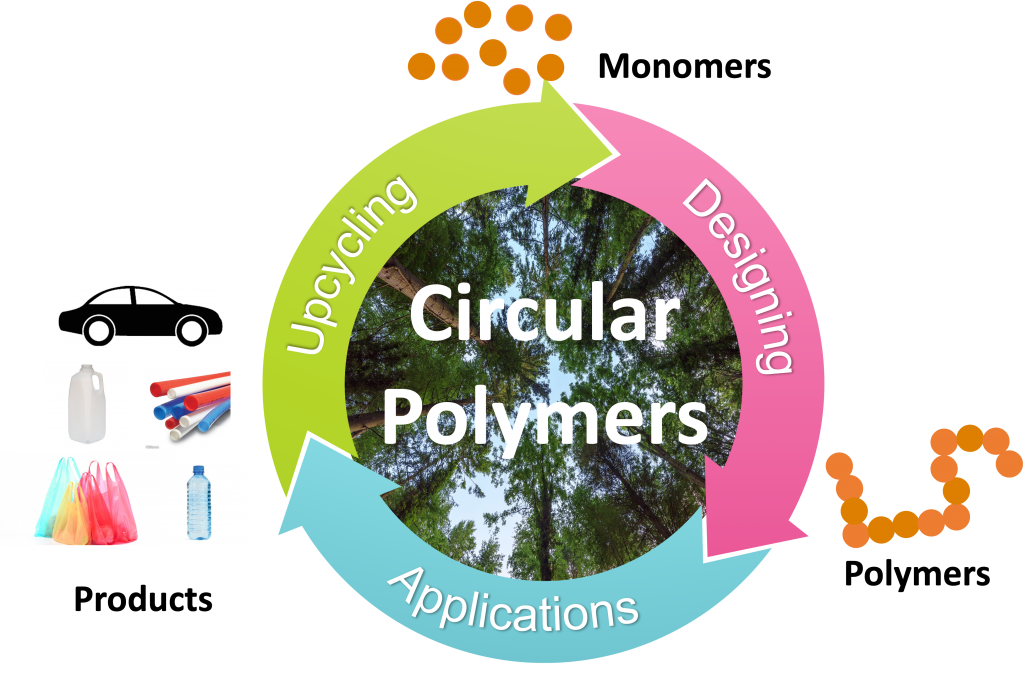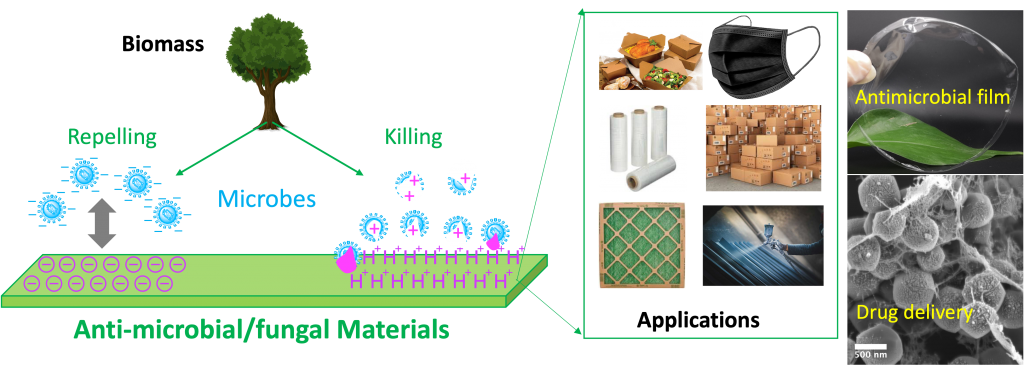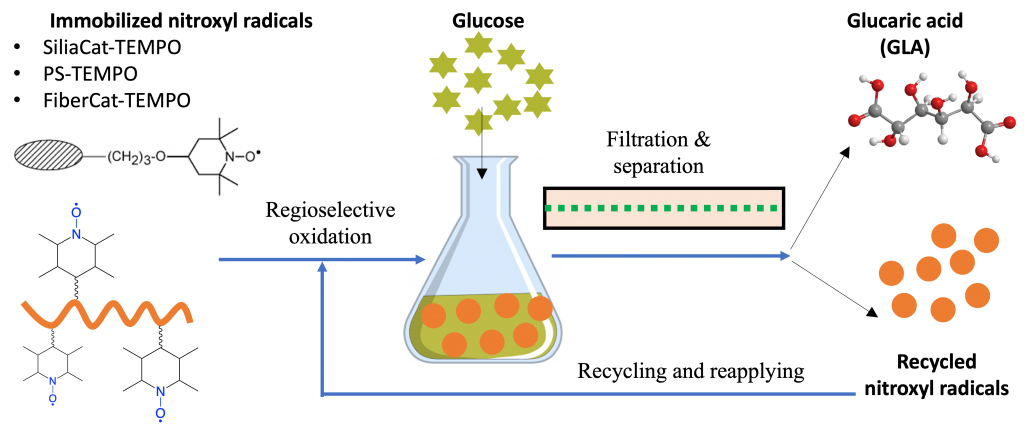Project 1: Synthesis Bio-derived Infinitely Recyclable Polymers for Future Plastics
Cheap, light, and versatile plastics have become indispensable materials essential to our modern life and economy. However, over 90% of plastics produced are currently derived from finite fossil feedstocks, and less than 10% of plastic wastes are recycled in the US in 2014. The current recycling method is dominated by mechanical recycling into lower-in-value products without further recycling. Plastic disposal through landfilling and littering creates severe worldwide environmental consequences in marine, soil, and water systems due to its difficult degradation in the environment. Therefore, we will manufacture 100% biomass-derived, highly recyclable, and biodegradable polymeric and copolymeric plastic that can be applied as packaging grocery bags. In this project, the starting lactone building block is quantitatively recovered using thermal and chemical degradation methods in the presence of catalysts. The recovered monomer can be used again for producing the lignin-grafted-polycaprolactone with similar property. This technology allows for produce chemically and infinitely recyclable plastic products. The goal of this project is to invent an integrated and cost-effective process to develop bio-based plastic with high recyclability and composability. The completion of this project will lead to a modern bio-based polymer to (1) reduce the environmental impact of current plastic waste, and (2) increase the economic values of forestry and agricultural feedstocks.

Project 2: Designing and Engineering Bio-derived Antimicrobial Materials
The ongoing worldwide COVID-19 pandemic reclaims urgent demands for preventative measures to curtail the spread of bacteria and viruses that have led to an unprecedented impact on the agricultural system. We will develop a novel type of nanocellulose-based self-disinfecting material to mitigate the impact of microbial contamination. We leverage the renewability, functionalizability, and nanomaterials features of nanocellulose to design long-lasting and regeneratable self-sterilizing capability. This novel functionality is endowed by introducing special functional groups to realize dual sanitizing effects—repelling microbes through negative charges and killing microbes through local surface acidity. The designed self-disinfecting materials can be rapidly and widely applied to the coating of packaging materials (paper, board, containers), personal protective equipment (face shields, masks), and high-contact surfaces (door handles, elevator buttons, public transportation surfaces, cellphone cases), replaceable films, composites, textiles, and biomedicals. This project will demonstrate a new approach beyond the current technical capacity for bio-derived value-added nanomaterials. It will support the improvement of the long-term sustainability of the US agricultural and food systems under the constraints of the growing population, climate change, natural resource depletion, and energy crisis, with significant advances in curbing food spoilage, plant and animal contamination, and disease infection and spreading for the agricultural and food systems.

Project 3: Biomass Fractionation and Valorization Using Green Technology
Nanocellulose has gained a lot of attention due to its high crystallinity, high mechanical strength, and reinforcing capabilities making it appealing for generating bio-derived materials and polymers. One key step in obtaining nanocellulose is the isolation of cellulose via pulping (breakdown of a biomass’s intercellular lignin glue) and bleaching (brightening of pulp by the removal of lignin). Bleaching typically involves chlorine, which can generate organochlorines that accumulate in the environment and food chain. Therefore, reducing or removing the use of chlorine in the pulping and bleaching process for nanocellulose isolation is highly demanded. In this project, we will use a totally chlorine-free method to isolate nanocellulose from four different plant sources—pine, poplar, switchgrass, and hemp, representing softwood, hardwood, monocots, and dicots, respectively. The geometry and physicochemical properties of isolated nanocellulose will be fully characterized. A commonly used sodium chlorite method will be used as a reference method. The project will (i) establish a fundamental process-structure-properties relationship and knowledge of nanocellulose for the biorefinery field, and (ii) provide the paper and pulping industry with an alternative to chlorine-based method with reduced aqueous pollution. The project will also proclaim societal acknowledgment and consensus to sustainable processing and bio-derived materials exploration.

Project 4: Converting Glucose to Value-added Glucarate Employing Novel Catalysts
Recent public awareness and echoing to environmental pollution further drives the search for alternative resources to the traditional and non-renewable fossil resources for energy and chemicals. Agro-crops and biomass can serve much more than food or feed but are a promising feedstock for biofuels and high-value chemicals of a wide range of industrial applications. The goal of this project is to develop novel technology to biomass-derived sugar into value-added chemicals. We will investigate the conversion of glucose into glucaric acid using efficient and recyclable oxidation catalysts. Glucaric acid is a promising chemical feedstock for the formation of biodegradable detergents, metal complexation agents, biodegradable polymers, films, adhesives, and plant fertilizers with wide applications. However, the current industrial glucaric acid is primarily produced by chemical oxidation of glucose using non-selective nitric acid oxidation, with several issues including poor yields (~55%), upscaling challenge, and large waste generation. Therefore, we will manipulate the high selectivity of nitroxyl radicals on the oxidation of sugar to acidic analogs. By designing the feature of catalysts, we will make effort to improve the conversion yield and selectivity, reduce reaction pollution, and increase economic feasibility. This project will (i) acquire knowledge for a fundamental understanding of the chemical conversion of sugars to their sugar acids (i.e., aldaric acids); (ii) help local and national farmers to discover and promote new and innovative market opportunities; and (iii) advance the Bioeconomy and Carbon Circular Economy.
